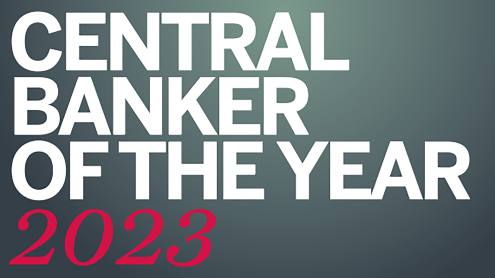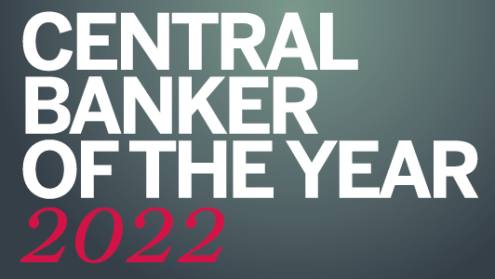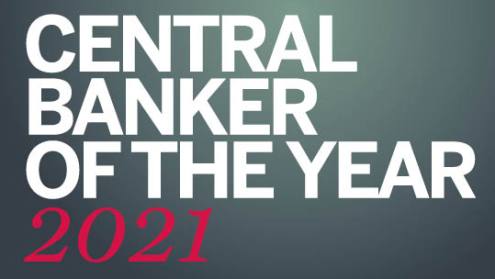Global and Americas
Ilan Goldfajn, Brazil
“We still have three weeks to go, but it’s been quite a remarkable year,” says Ilan Goldfajn, the governor of Brazil’s central bank, in an interview with The Banker in December 2017.
It has indeed, as Latin America’s largest economy is finally out of recession and inflation has been tamed, hovering beneath the bottom range of the bank’s target. This is far from an easy accomplishment in a country that has struggled with inflation rising at double digits in the recent past.
“[We entered 2016 with inflation] of almost 11%, and when we took over, inflation went down only slightly to 9%,” says Mr Goldfajn, who was appointed as the governor of the central bank in June 2016, after seven years as chief economist at Itaú Unibanco, the country’s – and the region’s – largest lender. He is not new to the monetary institution, having served as director of economic policy at the central bank earlier in his career, between 2000 and 2003, after which he joined one of Brazil’s better known investment funds, Gavea Investimentos.
Mr Goldfajn’s curriculum vitae is an interesting mix of private and public institutions, academia and international organisations, developed after his doctorate in economics at the Massachusetts Institute of Technology.
Such a profile is important, as controlling inflation requires a combination of both skill and trust. The latter, in particular, had been hardest to cultivate but, as he assumed the central bank governor’s chair, markets felt comfortable with what was to come. Business leaders followed suit.
“We had a challenge at the end of 2016 to anchor expectations before starting to reduce interest rates. [Succeeding in this] helped us quite a bit because expectations went down before inflation went down,” he says, adding that high inflation that year was caused by defensive pricing, where companies would not allow a slowdown in price growth because of concerns over it not being matched by a slower growth of their costs or of other prices in the market.
“They were very fearful of that [economic] environment. Once they had a new view of the future – because of changes at the central bank and a new [economic] model – they were willing to lower price [growth]. This helped inflation go down and the economy recover,” says Mr Goldfajn.
At 2.8% in November, beneath the 3% to 6% current target range, low inflation has allowed the benchmark interest rate, the Selic, to reach a record low of 7%, which markets expect will stay put in 2018 too, boding well for economic growth.
In 2018, the central bank will aim to reduce banking spreads, so that monetary policy can more fluidly reach the economy. Mr Goldfajn notes how the historical reform of the interest rate offered by the national development bank, BNDES (which will in time be brought in line with market rates), also goes in this direction. The Ministry of Finance, as well as the central bank, led the initiative, which was approved in 2017. Efforts will also continue to improve competition within the banking sector by supporting fintech firms, as well as to improve financial education.
But the main priority for 2018 will remain to keep inflation down. Mr Goldfajn says: “It’s very difficult to lose weight when you’re on a diet; but it’s much harder to preserve that weight once you’ve [slimmed down].”
Central Banker of the Year, Europe
Jirí Rusnok, Czech Republic
When, in April 2017, the Czech National Bank (CNB) exited its exchange rate commitment after some three-and-a-half years, the koruna resumed trading without any major market disruption. Efficient planning from governor Jirí Rusnok and his team made the move a success.
“The koruna did show some volatility in the first few days after the exit, but much less than many had expected or feared,” says Mr Rusnok. “Right from the start of using the exchange rate as a monetary policy instrument, we strove to make our future actions as transparent and credible as possible. Market participants and members of the public had all the necessary information about the future exit.”
Across 2017, the koruna appreciated gradually and ended the year about 5.5% stronger, but Mr Rusnok does not expect this to “destabilise the Czech economy in any way”.
Since lifting the cap, the CNB also started the process of gradually increasing interest rates from 0.05% at it lowest level to 0.5% as of mid-December. Inflation as of November was 2.6% – within the target range of 2% plus/minus one percentage point.
Throughout 2017, Mr Rusnok repeatedly highlighted the potential risk to financial stability caused by a spiral between property prices and mortgages, and took action. The CNB tightened the recommended upper loan-to-value limits and increased the counter-cyclical capital buffers that banks must hold against domestic lending to 1% by July 1 2018. On top of this, the return to a normalised monetary policy will further support financial stability.
“Monetary policy and macroprudential policy are now [moving] in the same direction and supporting each other in the fulfilment of the price and financial stability objectives,” says Mr Rusnok. However, he adds, this monetary policy would be overburdened and under-effective if interest rates were the only means to target both. “We will therefore continue to actively use macroprudential instruments and push for statutory powers to respond appropriately to risks connected with housing loans,” he says.
With economic growth rates of about 5%, Mr Rusnok sees no major economic challenges in the medium term.
“The important factor for our monetary policy… is when and at what pace the European Central Bank will start raising its interest rates,” he says. “Our ability to influence the domestic economy and keep inflation at our target will partly depend on that.”
Central Banker of the Year, Asia-Pacific
Ravi Menon, Singapore
The Monetary Authority of Singapore (MAS), the country’s central bank, stands out for its cutting-edge regulatory approach to fintech while maintaining macroeconomic stability. These are the key reasons for selecting Ravi Menon, managing director of MAS, as the Central Bank Governor of the Year for Asia-Pacific.
According to Mr Menon, mastering technology meaningfully allows financial institutions to improve risk management and cut costs. But safety remains paramount. “You can only encourage technology to the extent that you can also contain and manage its risks. A smart financial centre must be a safe financial centre as well,” he says.
MAS was among the first regulators to set up a dedicated fintech group that focuses on understanding technology’s risks and benefits. This has generated strong results. For instance, while some regulators still struggle to send out a clear message on cloud computing, MAS published cloud computing guidelines back in July 2016.
It also set up a data analytics group. “Data is a critical resource and those firms that can harness data and gain insights from [it] will have a large competitive advantage,” says Mr Menon. This group is also tasked with improving the collection and analysis of financial institutions’ data to help MAS shape regulation in a more efficient way.
“The way data is collected is quite primitive. [It is still collected via PDF documents or Excel spreadsheets.] It is a burden for the banks and also for us, because the data is not in a form that you can readily analyse,” says Mr Menon. MAS is already working towards having data streamed directly into its systems.
Singapore’s central bank, however, is not sacrificing safety at the altar of innovation. It does not impose “the full slew of regulatory requirements” on tech companies offering mass financial services because they do not pose a systemic risk, says Mr Menon.
However, he adds: “The risks we need to watch out for are money laundering, terrorism financing, cyber and technology risk, and customer confidentiality.” In terms of blockchain, “there is a lot more emphasis on cyber risks to make sure it doesn’t get hacked into”, says Mr Menon.
Central Banker of the Year, Middle East
Rasheed Mohammed Al Maraj, Bahrain
Bahrain may not be the largest financial centre in the Gulf but it is one of the most sophisticated. The development of a world-leading regulatory environment for financial services – coupled with a forward-looking embrace of digital innovations and financial technology – is in large part due to the progressive stance adopted by the Central Bank of Bahrain (CBB). And it is for these reasons that central bank governor Rasheed Mohammed Al Maraj has claimed the Middle East Central Bank Governor of the Year award for 2018.
Mr Al Maraj assumed the governorship in 2005 and under his leadership Bahrain has built on its already impressive credentials as a globally minded financial centre. Beyond a growing economy and low inflation environment, over the past 18 months the CBB has pursued a number of eye-catching initiatives in the fintech sector.
These include the development of a dedicated regulatory sandbox for fintech start-ups, launched in June 2017. The framework offered by the CBB is a virtual space open to existing licensees, as well as new local and foreign firms. The testing phase is nine months with a maximum three-month extension.
Moreover, in October 2017 the CBB established a dedicated fintech unit. This body will oversee the approval process for participation in the sandbox, as well as offering supervision of licensed companies, operations and activities. The move falls under the CBB’s broader ambition of financial digital transformation in the country.
On the regulatory front, the introduction of protected cell companies, investment limited partnerships and a trusts law all bode well for Bahrain’s position as a key financial hub. Collectively, these changes will open up new opportunities for business and investment structures to be developed in the country. In addition, they bring Bahrain’s structuring options to the level of best international practices.
In December 2017, the CBB also issued a new directive recognising both locally domiciled and foreign exchange-traded funds (ETFs) as collective investment undertakings. It means banks and other financial institutions can list ETFs established in Bahrain on licensed exchanges, while also permitting the registration of offshore ETFs. Notably, the new directive recognises both conventional and sharia-compliant funds.
Central Banker of the Year, Africa
Patrick Njoroge, Kenya
In a financial services market as large and as complex as Kenya’s, it helps to have a steady hand leading the apex bank. Dr Patrick Njoroge is just that. Since being appointed as central bank governor in July 2015, he has acted swiftly to clean up the country’s banking sector, improve supervision and guidance measures, and spearhead efforts to position Kenya as a hub for green finance. Monetary policy has remained stable and effective since late 2016 and inflation has generally remained within or close to the banks’ target range.
In August 2015, just months after taking office, Mr Njoroge moved quickly to close Dubai Bank Kenya (which has no relationship to Dubai Islamic Bank or Dubai Bank) following reports of liquidity challenges and serious mismanagement. That October, the central bank suspended the operations of another lender, Imperial Bank, based on similar concerns. As a result of these incidents, the central bank imposed a 16-month moratorium on the issuance of new banking licences to more effectively investigate the health of the sector.
Analysts saw these moves as a positive for a banking sector that had, in previous years, been subject to less scrutiny. In tandem, the central bank is bolstering its supervision capabilities by hiring additional inspection staff. In late 2017, the Central Bank of Kenya also drafted a banking penalty regulation that will see larger monetary penalties applied to banks that do not comply with the country’s banking laws.
Meanwhile, under Mr Njoroge’s guidance, the central bank has played an important role in launching a new green bond initiative in partnership with other Kenyan private and public sector bodies, as well as various international partners. While initial transactions are expected to be conducted by private entities, Mr Njoroge has said a sovereign green bond issuance may also be on the cards.
Looking ahead, the governor is keeping an eye on threats to Kenya’s financial sector, including those related to cyber security. In August 2017, the Central Bank of Kenya issued a guidance note on cyber security. Under the guidelines, the country’s banks are obliged to execute independent cyber threat assessments at least once a year, among other measures.
The governor’s prudence and long-term vision for Kenya’s economy and banking sector ensured that he scooped the Central Bank Governor of the Year award for Africa.






